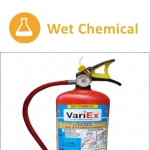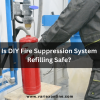What is class K fire extinguisher?
A Class K fire extinguisher is specifically designed for combating fires involving cooking oils and fats, commonly found in commercial kitchens. These extinguishers use a special type of fire-suppressing agent that reacts with the cooking oils to form a soap-like substance, effectively extinguishing the flames.
The Class K classification is part of the fire classification system, and these extinguishers are vital for addressing fires that may occur in restaurant kitchens, industrial kitchens, and other areas where large-scale cooking activities take place. The unique properties of Class K extinguishers make them highly effective and essential for ensuring kitchen safety.
Using a Class K fire extinguisher is crucial for tackling kitchen fires effectively. In the event of a fire:
Ensure everyone's safety by activating the fire alarm. Locate the Class K fire extinguisher within the kitchen. Stand at a safe distance from the fire, allowing for an accessible escape route. Remove the safety pin from the extinguisher, breaking any tamper seal. Aim the nozzle or hose at the base of the flames, not directly into the fire. Squeeze the handle to release the fire-suppressing agent. Sweep the extinguisher from side to side, covering the entire fire area. Maintain awareness of the fire's status, and continue evacuation if necessary. If the fire persists or poses a significant threat, evacuate the area immediately and call the fire department.
Understanding Class K Fires
In the realm of fire safety, the term "Class K" refers to a specific type of fire that involves cooking oils, fats, and greases. To grasp the essence of a Class K fire, imagine a bustling kitchen, the sizzle of a frying pan, and the aromatic wafts of a delicious meal being prepared. Now, add an unexpected twist – a sudden flare-up due to the ignition of hot oils or fats.
What Defines a Class K Fire?
Class K fires are unique in that they are fueled by substances commonly found in kitchens, such as vegetable oils, animal fats, and cooking greases. These fires pose a distinct challenge because water, the conventional extinguishing agent for many types of fires, is not effective against Class K fires. In fact, using water on a Class K fire can exacerbate the situation by causing the hot oils to splatter and spread the flames.
Common Culprits of Class K Fires
Picture a scenario in a commercial kitchen where large quantities of oil are used in deep fryers, grills, or other cooking appliances. In the event of overheating or an equipment malfunction, the oil can reach its ignition point, leading to a Class K fire. Restaurants, cafeterias, and any establishment where substantial cooking activities take place are particularly susceptible to these types of fires.
The Unique Challenge of Class K Fires
One of the defining characteristics of Class K fires is their persistence. The high temperatures at which cooking oils and fats burn can make them challenging to extinguish. Traditional fire suppression methods might not be effective, emphasizing the need for specialized tools, such as Class K fire extinguishers, designed to tackle these specific types of fires.
Why Water is Ineffective
Water is the go-to extinguishing agent for many fire types because it cools the burning material and removes heat. However, in the case of a Class K fire, water fails to provide a solution. When water comes into contact with hot oils or fats, it evaporates quickly, causing steam. This steam can carry droplets of burning oil, spreading the fire rather than putting it out.The Role of Class K Fire Extinguishers
To combat the unique challenges posed by Class K fires, specialized fire extinguishers containing a wet chemical agent are employed. These extinguishers work by forming a soapy foam on the surface of the burning oil or fat, preventing the release of flammable vapors and effectively suppressing the fire.
Components of a Class K Fire Extinguisher
Cylinder and Agent
Dive into the anatomy of a Class K fire extinguisher, exploring the materials used in the cylinder construction and the specialized fire-suppressing agent contained within.
Nozzle and Discharge Hose
Understand the critical components responsible for directing and delivering the extinguishing agent to the fire source, ensuring proper coverage and effectiveness.
Operating Mechanism Explore the mechanism used to activate a Class K fire extinguisher, providing insights into the simple yet effective technology employed for quick response in emergency situations.Choosing the Right Class K Fire Extinguisher
Matching the Extinguisher to the Fire Risk
Discuss the importance of conducting a fire risk assessment and selecting the appropriate Class K fire extinguisher based on the specific needs and potential hazards in a given environment.
Installation and Placement Guidelines
Explore best practices for installing and positioning Class K fire extinguishers, considering factors such as proximity to cooking appliances, accessibility, and visibility.
Inspection and Maintenance Requirements
Highlight the importance of regular inspections and maintenance to ensure the reliability of recharge a Class K fire extinguishers. Provide a checklist for routine checks and guidance on professional maintenance.Steps for Using a Class K Fire Extinguisher
Assessing the Situation
Guide users through a step-by-step process of evaluating the fire scenario, emphasizing the importance of personal safety and ensuring the right extinguisher is used.
Activating the Fire Extinguisher
Detail the steps involved in activating recharge a Class K fire extinguisher, including removing safety pins, aiming the nozzle, and pressing the discharge lever.
Proper Technique for Discharging the Agent
Instruct on the correct sweeping motion to apply the extinguishing agent effectively, covering the entire fire source and preventing re-ignition.
Monitoring the Fire
After using the extinguisher, provide guidance on monitoring the fire site for potential re-ignition and taking additional safety measures if necessary.
Safety PrecautionsPersonal Protective Equipment
Emphasize the importance of using appropriate personal protective equipment (PPE) when handling Class K fires, including fire-resistant clothing and eye protection.
Evacuation Procedures
Outline evacuation procedures in case the fire cannot be controlled with a Class K extinguisher, stressing the significance of a well-defined evacuation plan.
Communication during an Emergency
Discuss effective communication strategies during a fire emergency, including the use of alarms, emergency numbers, and clear instructions for personnel.After Using the Class K Fire Extinguisher
Confirming the Fire is Extinguished
Provide a checklist for confirming the successful extinguishment of the fire, ensuring that all potential sources of ignition are addressed.
Reporting the Incident
Highlight the importance of reporting any fire incident, regardless of size, to the appropriate authorities for documentation and future prevention measures.
Securing and Cleaning the Extinguisher
Offer guidance on securing the used extinguisher, preventing tampering or misuse, and cleaning any residue to maintain the equipment in optimal condition.Recharging a Class K Fire Extinguisher
Determining the Need for Recharging
Educate users on the signs that indicate and needs to recharge a Class K fire extinguisher, emphasizing the importance of regular inspections.
Professional Recharging vs. DIY Recharging
Discuss the advantages of professional recharging services and discourage DIY recharging due to safety and regulatory concerns.
Steps for Recharging
If professional recharging is required, outline the steps involved, including discharging any remaining agent, inspecting internal components, and refilling with the appropriate fire-suppressing agent.
Training and FamiliarizationEmployee Training Programs
Highlight the significance of training programs for individuals likely to encounter Class K fires, ensuring they are familiar with the proper use of extinguishers and emergency procedures.
Regular Drills and Exercises
Encourage regular fire drills and exercises to reinforce training, enhance response times, and familiarize personnel with emergency protocols.
Staying Informed about Fire Safety
Promote ongoing education and staying informed about advancements in fire safety technology, regulations, and best practices.
![]()










